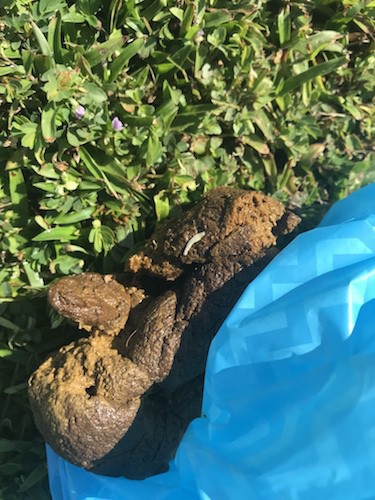Question: What are these worms in my dog’s stool?
I found a worm crawling out of my dog’s butt. The day after, I found multiple worms in her stool. How do I find out what type of worm she has?
–Brianna
Answer:
Dear Brianna,
In our civilized world, we are often lulled into a false sense of sterility. The fact is that there are organisms all around us, some visible and some not. I’m sure it was a surprise when you first saw a little worm on your dog!
Many organisms parasitize our pets, including various worms. Some worms are only found with microscopic examinations of stool while others pass intact with the stool.
Most Common Small Worms
Tapeworms look like short, flat whitish worms passed with stool. Occasionally, you’ll see many segments joined together in a longer form. These segments are not the worm itself but rather segments containing eggs that have been shed by the larger adult tapeworm in the intestine. Single segments are about half an inch long (12 mm) and about 1/8 inch wide (3 mm).
The two most common tapeworms that infest dogs in the United States are Dipylidium caninum and Taenia pisiformis. It’s very difficult to tell the difference between the two without a microscope.
Dipylidium caninum is species of tapeworm that begins its life cycle inside a flea. Dogs ingest fleas carrying tapeworm larvae in the course of grooming or licking themselves. Once inside a dog’s digestive tract, the larvae grow into adult tapeworms.
Taenia pisiformis tapeworms start their life cycle in a dog and shed eggs in the dog’s feces. The eggs are then ingested by a rabbit or rodent and grow inside the animal until it is eaten by a dog. Then the life cycle begins again.
Tapeworm Diagnosis and Prevention
To summarize, dogs acquire a Dipylidium caninum infestation from ingesting fleas. Taenia pisiformis infests dogs after they eat an affected rabbit or rodent. To prevent these tapeworms from infesting your dog, focus on flea control and rabbit/rodent control.
To find out which form of tapeworm your dog has, take one or more of the white segments to your veterinarian. She can look at it under a microscope to identify the type. This is important so you know how to prevent future tapeworm infestations. While you’re at it, take a small stool sample from your dog to your vet to have it tested for other parasites.
Treating Your Dog for Tapeworms
Although the tapeworms are a parasite, they usually don’t cause any symptoms or health problems. Some dogs may have an itchy bottom from the wriggling of the worms on their way out of the body. Still, most people want to get rid of the worms as quickly as possible.
Treatment of tapeworms involves administration of an anti-tapeworm medication, usually in the form of a pill given once or twice. Praziquantel is a widely used dewormer and is effective against both Dipylidium caninum and Taenia pisiformis.
Here’s a bit of good news: your dog can’t pass the tapeworms to humans or other dogs. Both types of tapeworms require either a flea or a rodent/rabbit to complete its life cycle. However, if your dog has fleas, there is the potential that a human (especially children) could accidentally ingest an infected flea and contract Dipylidium caninum. That’s another good reason to deworm your dog and use aggressive flea control measures.
Sincerely,
TB Thompson DVM
Disclaimer: Your use of the Ask The Vet feature is subject to the Ask The Vet Terms of Use.































